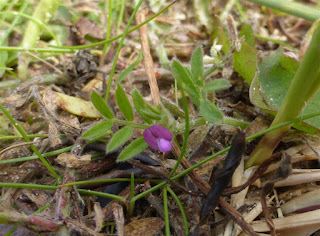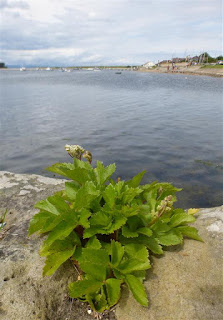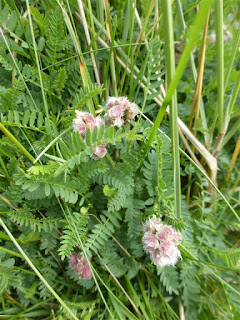Moray VC95, Wild Flower Society meeting Mon 13th – Thurs 16th
July 2015. Report by Dawn Nelson.
Thursday 16th July 2015.
 |
Spring Vetch
Image: D. Nelson |
We were barely 30 paces from the cars when Ian drew our attention to a
profusion of Ophioglossum azoricum (Small Adder’s-tongue). There must have been
over 50, most with fertile blades
Small flowering treasures included Hypochaeris
glabra (Smooth Cat’s-ear) and Vicia lathyroides (Spring Vetch).
 |
Scots Lovage
Image: D. Nelson |
Then we were shown foliage of established plants of Clematis tangutica (Orange-peel Clematis), Ligustrum scoticum (Scots Lovage) was also admired. Heading westward we found Vulpia fasciculata (Dune Fescue) and the intergeneric hybrid X Festuca hubbardii (Red Fescue x Dune Fescue), both of which were enthusiastically examined.
The airborne fragrance of Rosa rubiginosa (Sweet Briar) caught our
attention and not far away we found Astragalus danicus (Purple Milk-vetch)
sadly past flowering, although the fluffy fruits were looking good.
Exploring around the village and harbour area we found Descurainia
sophia (Flixweed), some escaped Kniphofia x praecox (Greater Red-hot-poker)
showing its exserted stamens and Malva neglecta (Dwarf Mallow).
 |
Purple Milk-vetch
Image: D. Nelson |
At the top of a
slipway we got down on our hands and knees to examine Trifolium suffocatum
(Suffocated Clover) and Trifolium ornithopodiodes (Fenugreek).
As we headed back
to the cars, we ticked off a few more
goodies including Geranium pusillum (Small-flowered Crane’s-bill) Crassula
tillaea (Mossy Stonecrop) and Teesdalia nudicaulis (Shepherd’s Cress).
Findhorn Bay beckoned so off we went. Here we saw a typical
salt marsh selection of plants including Centaurea littorale (Seaside
Centaury), Carex extensa (Long-bracted Sedge) and Blysmus rufus (Saltmarsh
Flat-sedge) plus a well-known location for the rare RR Euphrasia foulaensis
(Foula Eyebright).
 |
Foula Eyebright
Image: D. Nelson |
Ruppia maritima (Beaked Tassleweed) was found in the wetter
places but the tide was too high to get to the RR Zostera noltei (Dwarf
Eelgrass) however we came back later and went out onto the mud flats to see it.
In the meanwhile we went to our last location of the trip -
Burghead Beach from where Mertensia maritima (Oysterplant) has been recorded
and was seen here by Ian last year.
This is another of the RR plants I have
wanted to see for a long time, it is on the Red List, has not been recorded in
England since 1995 and is classified as Near Threatened in Great Britain.
But
sadly, despite an extensive search, our luck wasn’t in today.
 |
Examining Festuca x hubbardii
Image: D. Nelson |
However we had an
enjoyable walk along the shore and found a few nice aliens in and around the
community garden such as Artemisia verlotiorum (Chinese Mugwort) and Anisantha
diandra (Great Brome).
So two plants I have wanted to see it for some years now, were
not accommodating - but that’s another good excuse to come back to this
wonderful area at a different time of year.
I honestly find it hard to believe
that this is not regarded as one of the honeypot areas for botanising. I added
43 new species to my life list.
 |
Dwarf Eelgrass
Image: D. Nelson |
It was a great three and a half day meeting, with an
exceptionally good leader; it was really enjoyable exploring such a selection
of plant rich habitats, as well as being in the company like-minded folk. Even
the weather was good".
Many thanks to Dawn for this report - let's hope she gets to see Oysterplant Mertensia maritima at some point!
If you don't know what this rare and photogenic plant looks like, click here to see some pix of a right royal Oysterplant that BSBI members were privileged to see a few years ago.








